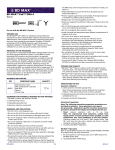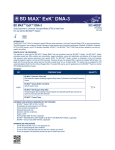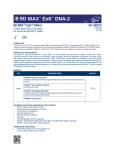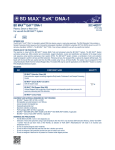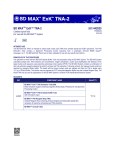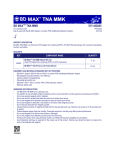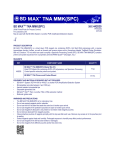Download ExK DNA-1 Package Insert - BD Molecular Diagnostics
Transcript
BD MAX™ ExK™ DNA-1 (Plasma, Serum or Neat Urine) 442817 25°C 2°C For use with the BD MAX™ System INTENDED USE The BD MAX™ ExKTM DNA-1 is intended to extract DNA from plasma, serum or neat urine specimens. The DNA Extraction Tube contains a Specimen Processing Control (SPC) sequence from Drosophila melanogaster (GenBank: AC246436; nucleotides 35779 to 35978) cloned in a pUC119 derivative (GenBank: U07650.1). The BD MAX™ ExKTM DNA-1 has not been validated for use with any specific analytical test method. PRINCIPLES OF THE PROCEDURE The specimen is mixed with the BD MAX™ Sample Buffer Tube and processed using the BD MAX™ System. The BD MAX™ System automates DNA extraction and concentration. No operator intervention is necessary once the specimen is loaded onto the BD MAX™ System. The BD MAX™ System contains a combination of lytic and extraction reagents designed to perform cell lysis, DNA extraction and removal of inhibitors. Following cell lysis, the released DNA is captured by magnetic affinity beads. The beads, with the bound DNA, are washed and the DNA is eluted using 12.5 μL of Elution Buffer. The solution may be prepared for PCR using neutralization buffer from the DNA strip. The eluted DNA may be used for applications on the BD MAX™ System or another PCR Amplification/Detection System. REAGENTS AND SUPPLIES REF 442817 COMPONENT NAME DNA Extraction Tube DNA Sample Buffer Tube SB-1 DNA Strip Septum Conical Tube QUANTITY 24 EQUIPMENT AND MATERIALS REQUIRED BUT NOT PROVIDED 1. BD MAX™ System: REF 441916 or 441927 2. Micropipettes (accurate between 2 and 1000 μL) 3. Aerosol resistant micropipette tips 4. Disposable gloves/lab coat 5. Specimen collection container(s) WARNINGS AND PRECAUTIONS • This kit is for in vitro diagnostic use. • Do not use this kit if the outer carton safety seal is broken. • Do not use this kit if the packaging is damaged upon arrival. Extraction of neat urine specimens using a lysis temperature other than 62°C may decrease DNA extraction efficiency. • Do not use reagents if their protective pouches are open or broken upon arrival. • Do not use reagents if desiccant is not present or broken inside protective pouches. • Do not remove desiccant from protective pouches. • Close protective pouches promptly with the zip seal after each use. Remove any excess air in the pouches prior to sealing. • Do not use reagents if their foil seal has been opened or damaged (DNA Extraction Tube, DNA Strip). P0121(03) 1/3 • Proceed with caution when using chemical solutions as Master Mix and Extraction Tube barcode readability may be altered. • Check DNA Strips for proper liquid fills (ensure that the liquids are at the bottom of all three (3) buffer tubes; if necessary gently tap the DNA Strips until the liquids move to the bottom of tubes, see Figure 1). • Check DNA Strips to ensure that all four (4) pipette tips are present (see Figure 1). • Protect reagents against heat and humidity. Prolonged exposure to humidity may affect product performance. • Reagents are not interchangeable between lots. • Never pool reagents from different tubes even if they are from the same lot. • Do not interchange caps among reagents as contamination may occur and compromise test results. • Do not use reagents after expiration date. • Avoid microbial and deoxyribonuclease (DNase) contamination of reagents at all times. The use of sterile DNase-free disposable aerosol resistant or positive displacement pipette tips is recommended. Use a new tip for each specimen. • Always handle specimens as if they are infectious and in accordance with safe laboratory procedures such as those described in Biosafety in Microbiological and Biomedical Laboratories1 and in CLSI Document M292. • Wear personal protective equipment and non-powdered disposable gloves while handling all reagents. Wash hands thoroughly after performing the test. • Do not pipette by mouth, smoke, drink, or eat in areas where specimens or kit reagents are being handled. • Dispose of unused reagents and waste in accordance with country, federal, provincial, state and local regulations. • Consult the BD MAX™ System User's Manual (REF 441939 or 441942) for additional warnings, precautions and procedures. STORAGE AND STABILITY • BD MAX™ ExKTM DNA-1 is stable at 2-25°C through the stated expiration date. The expiration date applies only to unopened kits, stored as directed. Do not use expired components. • BD MAX™ ExKTM DNA-1 Extraction Tubes are provided in sealed pouches. To protect product from humidity, immediately re-seal after opening. Reagent tubes are stable for up to 7 days at 2-8 °C after initial opening and re-sealing. INSTRUCTIONS FOR USE Specimen Collection 1. Collect specimen and label appropriately. Note: Plasma specimens must be obtained from sodium citrate or EDTA anticoagulated blood. Other anticoagulants have not been evaluated. 2. Collected specimens should be maintained per the conditions validated by the user. 3. Proceed to Extraction Preparation. Extraction Preparation Note: The following extraction preparation procedures are provided as guidance. Some specimens may require pre-processing. Application-specific extraction preparation procedures should be developed and validated by the user. 1. Plasma, Serum and Neat Urine: Pipette 750 μL of specimen into a BD MAX™ DNA Sample Buffer Tube SB-1 and close the tube with a septum cap. Ensure complete mixing by vortexing the sample. 2. Proceed to BD MAX™ Operation. BD MAX™ Operation Refer to the BD MAX™ System User's Manual (REF 441939 or 441942) for programming and setup instructions. 1. For each specimen to be tested, place one (1) DNA Strip on the 2012-11 BD MAX System Rack. 2. Assemble BD MAX™ DNA Strips. a. Snap the appropriate DNA Extraction Tube into Position 1 of the DNA Strip, as shown in Figure 1. The tube is fully seated in the strip when a ‘click’ is heard. Only one (1) DNA Extraction Tube should be used with each DNA Strip. b. If performing DNA extraction only, snap the Conical Tube into Position 3 of the DNA Strip, as shown in Figure 1. The tube is fully seated in the strip when a ‘click’ is heard. Proceed to Step 3 below. c. If the BD MAX™ System is also being used for DNA amplification using BD MAX™ DNA MMK (SPC) or BD MAX™ DNA MMK (REF 442829 or 442848), follow the instructions for use accompanying that product. Snap the MM tube into Position 2 and snap the Conical tube into Position 3 of the DNA Strip, as shown in Figure 1. The tubes are fully seated in the strip when a ‘click’ is heard. Pipette 12.5 μL of primer and probe mixture (at a final concentration of 2X) into the Conical Tube in Position 3 of the DNA Strip. Proceed to Step 3 below. d. If the BD MAX™ System is being used for DNA amplification with a user supplied master mix, snap a Conical Tube into Position 3 of the DNA Strip, as shown in Figure 1. The tube is fully seated in the strip when a ‘click’ is heard. Prepare liquid primer and probe mixture for target(s) and user-provided sample processing control. Pipette a total of 12.5 μL of the user supplied master mix, primers and probes (at a final concentration of 2X) into the Conical Tube in Position 3 of the DNA Strip. Add user-provided sample processing control to the Sample Buffer Tube. Proceed to Step 3 below. 3. Select the ‘Work List’ tab in the ‘Run’ screen on the BD MAX™ System monitor. NOTE: FOR NEAT URINE SPECIMENS ONLY: Create a user defined protocol with a modified lysis temperature. The lysis temperature must be changed from the default temperature of 37°C to 62°C. Refer to the BD MAX™ System User's Manual (REF 441939 or 441942) for programming and setup instructions. 4. Enter the specimen/patient identification number into the BD MAX™ System, using either the barcode scanner or manual entry. Start with Position 1 of Rack A. (Rack A is positioned on the left side of the BD MAX™ System and Rack B is on the right, Figure 2). 5. Enter the Sample Buffer Tube barcode corresponding to each specimen/patient using the barcode scanner or manual entry. Start with Position 1 of Rack A and ensure that the specimen/patient ID and the Sample Buffer Tube are accurately matched. 6. Place the Sample Buffer Tube (containing the specimen) on the BD MAX™ System Rack. Start with Position 1 of Rack A. 7. Repeat Steps (1-6) for all specimens. Always move from Position 1 through Position 12 on each Rack, ensuring that no positions are skipped. 8. If the BD MAX™ System is also being used for DNA amplification, include additional disposables, as required. 9. Load Rack(s) into the BD MAX™ System (Figure 2). Ensure that the placement of the Rack(s) corresponds to the ‘Work List’ definition. 10. Close the BD MAX™ System door and press Start to begin the test run. P0121(03) 2/3 Figure 1. DNA Strip Figure 2. BD MAX™ System Rack A Rack B LIMITATIONS OF THE PROCEDURE 1. The BD MAX™ ExKTM DNA-1 can only be used on the BD MAX™ System by trained personnel. 2. Use of the BD MAX™ ExKTM DNA-1 for clinical specimen types other than those specified have not been validated. 3. Plasma obtained from blood anticoagulated by methods other than sodium citrate and EDTA have not been validated. 4. Use of BD MAX™ ExKTM DNA-1 for neat urine specimens has only been validated with a lysis temperature of 62°C. 5. The user must validate the selected application of this product according to country, federal, provincial, state, local and/or accrediting organization guidelines, regulations and standards. REFERENCES 1 Centers for Disease Control and Prevention. Biosafety in Microbiological and Biomedical Laboratories. Chosewood LC and Wilson DE (eds) (2009). HHS Publication number (CDC) 21-1112. 2 Clinical and Laboratory Standards Institute. Protection of laboratory workers from occupationally acquired infections; Approved Guideline – Document M29 (Refer to the latest edition). 2012-11 SYMBOL MEANING SYMBOL MEANING Catalog number Batch code Use by Temperature limitation Contains sufficient for "n" tests Consult instructions for use Reseal pouch after use Keep dry Manufacturer In vitro Diagnostic Use Technical Information: In the United States, telephone Technical Services, toll-free (800) 638-8663. GeneOhm Sciences Canada, Inc., 2555 boul. du Parc-Technologique, Québec, Qc, Canada G1P 4S5 BD, BD Logo and all other trademarks are property of Becton, Dickinson and Company. © 2012 BD. Made in Canada P0121(03) 3/3 2012-11



